We may be compensated if you purchase through links on our website. Our team is committed to delivering honest, objective, and independent reviews on home products and services.
Project details
Skill
Cost
Estimated Time
Creating a bold, dramatic focal point in your room can be as simple as painting a dark accent wall. For this project, we teamed up with our friends at Sherwin-Williams® to walk you through selecting the perfect color to applying the final coat. Watch the video above to see how to use the ColorSnap® Visualizer mobile app by Sherwin-Williams. Jenn Largesse from House One demonstrates the steps to achieve a stunning black accent wall that complements a mid-century-style desk.
Choosing the Right Paint Color
Selecting the perfect dark color for your accent wall can be tricky. Consider the following factors when making your choice:
- Desired mood and atmosphere: Dark colors can create a cozy, intimate, or dramatic effect depending on the shade. Think about the emotional response you want to evoke in the space, whether it’s a sense of warmth, sophistication, or relaxation.
- Existing decor and color scheme: The accent wall should complement the existing decor by interacting with the current furnishings, textiles, and other walls. Choose a dark color that enhances the overall aesthetic rather than clashing with it.
- Room size and lighting: Dark colors can make a room feel more enclosed, so consider how to balance the depth of the color with the available natural and artificial light. A well-lit room can balance darker shades without feeling too confined.
For this project, Largesse uses Tricorn Black SW 6258 by Sherwin-Williams, which has a soft matte finish. To help visualize how different colors will look in your space, consider using the Paint-a-Scene feature in the ColorSnap Visualizer app. This tool allows you to preview colors in real time by holding your phone up to the wall.

Complementing Your Existing Decor
Think about your existing furniture and decor when deciding on a color for your accent wall. In the video above, Largesse pairs the black accent wall with a mid-century-style desk, creating a striking contrast that enhances the overall look of the room.
Testing Samples
Before committing to a color, test samples on your wall to see how the color looks in varying lighting conditions throughout the day. Paint a few large swatches and observe them for a few days before making your decision.
Gathering Materials and Tools
Here’s a list of what you’ll need for this project:
- Sherwin-Williams Emerald Interior Acrylic Latex Paint
- Paint tray and liners
- 2½-inch angled tip synthetic paintbrush
- Roller frame with a 3/8-inch nap roller cover
- Drop cloth
- Painter’s tape
- Spackle
- Sanding sponge
- Lint-free cloth
- Warm water
- Paint stirrer
Investing in high-quality materials—especially paint—will give you better coverage and a more professional-looking result. Largesse recommends using Sherwin-Williams Emerald Interior Paint, which offers excellent coverage with its paint and primer in one formula.
Preparing the Wall for Painting
Using a lint-free cloth and warm water, wash the wall and remove all grease, dirt and grime. Fill nail holes with spackle. Sand the area smooth, and wipe the dust from the wall.

Protecting Surrounding Areas
To protect adjacent walls, baseboards, and flooring, take the following precautions:
- Apply painter’s tape along the edges of the wall where it meets the ceiling, adjacent walls, and baseboards.
- Lay a drop cloth on the floor along the base of the wall to catch any drips or spills.
- Remove or cover any nearby furniture or fixtures that could be accidentally splattered with paint.

Painting Techniques for Dark Colors
Painting with dark colors requires specific techniques for even coverage and a smooth finish. Here are some tips to keep in mind.
Cutting In
Cut in along the edges of the wall using a 2-and-1/2-inch angled-tip synthetic paintbrush. This technique involves painting a 2–3 inch border around the edges of the wall where it meets the ceiling, adjacent walls, and baseboards. Take your time with this step to achieve clean, straight lines.
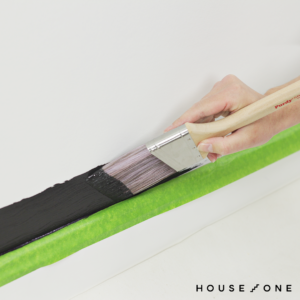
Rolling Technique
When using a roller to apply the paint, follow these steps for the best results:
- Pour paint into the tray, filling it about halfway.
- Dip the roller into the paint, then roll it back and forth on the tray’s ridged area to distribute the paint evenly.
- Begin applying paint to the wall using overlapping W-shaped strokes.
- Work in sections, maintaining a wet edge to avoid visible lines between areas.
- Apply even pressure to ensure consistent coverage.

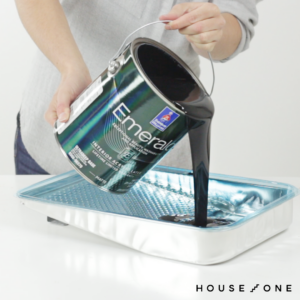
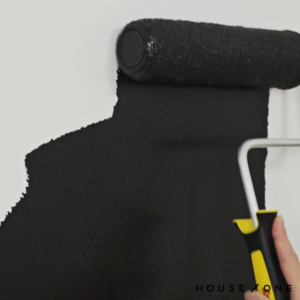
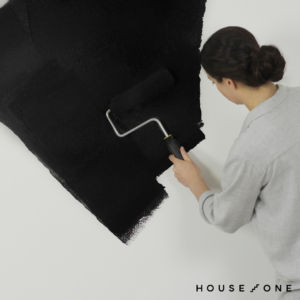
Applying Multiple Coats
Dark colors often require multiple coats for full coverage. Allow each coat to dry completely before applying the next. Two coats are usually sufficient, but you may need a third for particularly deep or rich colors.
Finishing Touches for Dark Paint
Once you’ve applied the final coat of paint, there are a few more steps you should take to complete your dark accent wall. While the paint is still tacky, carefully remove the painter’s tape at a 45-degree angle to avoid peeling off any paint. Let the paint dry overnight before hanging any decor or placing furniture against the wall. Touch up any small imperfections or missed spots with a small brush.
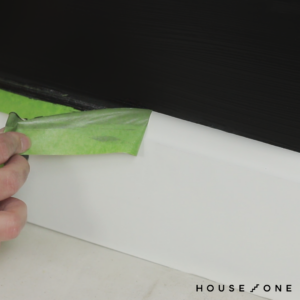
Styling Your Dark Accent Wall
To make the most of your new dark accent wall, consider these styling tips:
- Consider adding accent lighting to highlight the wall and create a dramatic effect.
- Incorporate textures through artwork, tapestries, or shelving to add depth to the space.
- Use light-colored or metallic decor to create contrast and visual interest.
Enhancing Your Space With Bold Design Choices and Lighting
Your dark accent wall can serve as a springboard for other bold design choices in your room. Consider pairing it with complementary textures, patterns, and colors. For example, a richly textured area rug or patterned throw pillows can bring out the vibrancy of the dark wall.
Adding texture and patterns can elevate the overall look of the room. Think about incorporating velvet or leather furniture, geometric or floral-patterned throws, and textured area rugs.
Proper lighting ensures your dark-painted room is well-lit and doesn’t feel too dark or closed in. Use a mix of ambient, task, and accent lighting to create a balanced and inviting space. Opt for light fixtures with metallic finishes to reflect light and add a touch of elegance. Consider installing wall sconces or track lighting to highlight the dark accent wall and enhance its impact.
Practical Tips for a Seamless Painting Project
Rushing through these steps can lead to mistakes and less-than-perfect results. Allocate sufficient time for each stage of the painting process, from preparation to drying. Painting can also be a fun and collaborative activity. Enlisting family members or friends to help with the project can make it more enjoyable and efficient. Remember to take your time, and don’t be afraid to make a bold color choice.




